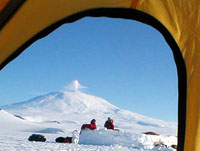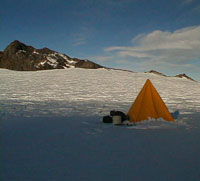|
|

|
|

|
Mt.
Erebus erupting. Click to enlarge.
|

|
|
|
|

|
|
Mt.
Erebus
|

|
Volcano
on Ice
Part 1: Getting There
by Paul Doherty
December
19, 2001
At
Snow School, we learned how to camp in a tent in Antarctica.
When I awoke and looked out the tent door in the morning,
there was Mount Erebus. A huge white plume rose out of its
summit crater 12,500 feet above me. The plume reminded me
that Erebus is an active volcano. What a strange image, an
active volcano rising above the ice of Antarctica. I remembered
that when Erebus was first spotted by James Ross in 1841,
it was erupting, and has been erupting ever since.
Noel
and I were scheduled to visit Professor Phil Kyle and his
team of geologists who live near the summit of Erebus and
to join them on a data collecting expedition to the rim of
the active crater. What I didn't know was how important our
Snow School training would be to help us survive the storms
that we would encounter on the mountain.
It
took the men of Shackleton's Expedition five days in 1908
to hike from their camp, near what is now McMurdo Station,
to the summit of Mt. Erebus. They complained about the cold
winds on the mountain. As a mountain climber, I would love
to have repeated their route. However this time I would be
given a lift via helicopter to the science camp known as Lower
Erebus Hut (LEH) sitting on a flat plateau 11,500 feet up
the mountain.
Rapid
ascent to the Lower Erebus Hut is dangerous to human bodies.
In the past 20 years over a dozen people have had to be evacuated
from the science camp because they suffered from altitude
sickness. So now, anyone going to the Lower Erebus Hut for
more than eight hours is required to stop part way up the
mountain at Fang Camp for 48 hours to allow their bodies to
adapt to altitude. As a result, we would spend a total of
five days on the mountain.
The
reason its called Lower Erebus Hut is that there used to be
an upper hut, but in 1984, the mountain spit out volcanic
bombs the size of Volkswagens that threatened to crush the
upper hut so it was abandoned for the safer and more distant
lower hut.
|
|

|
|

|
Fang
camp at "sunset." The sun sets behind the cone
of Erebus. Click to enlarge.
|

|
|
|
|

|
Local
mountain expert Matt Irinaga from the Berg Field Center accompanied
us to the mountain. Our helicopter pilot, Barry, whisked us
up to a flat campsite behind a black cliff known as Fang Ridge.
Fang Ridge is the rim of the old caldera (a volcanic crater)
of Erebus, the new cone rises far above the old caldera. Two
Scott tents were set up waiting for us. Thank goodness for
that. No sooner had we arrived, when a strong wind sprang
up. Noel reported that his bare hand on the video camera controls
lost feeling in about ten seconds, so we dove for the shelter
of the Scott tents.
We
rode out the storm in the tents for two days. This is a tough
place to do science. Then the storm cleared, and a helicopter
gave us a lift to Lower Erebus Hut to meet the geologists
who live on this volcano for eight weeks at a time.
When
the helicopter landed, we got to meet the team of geologists.
|

